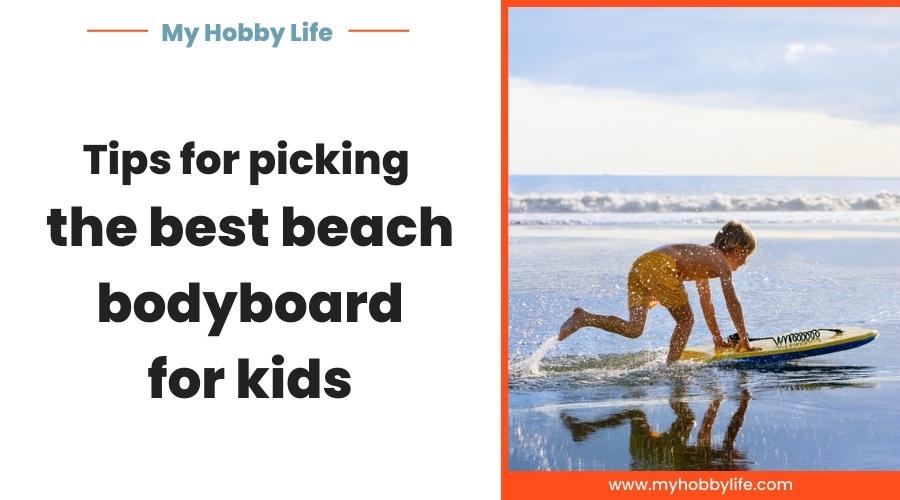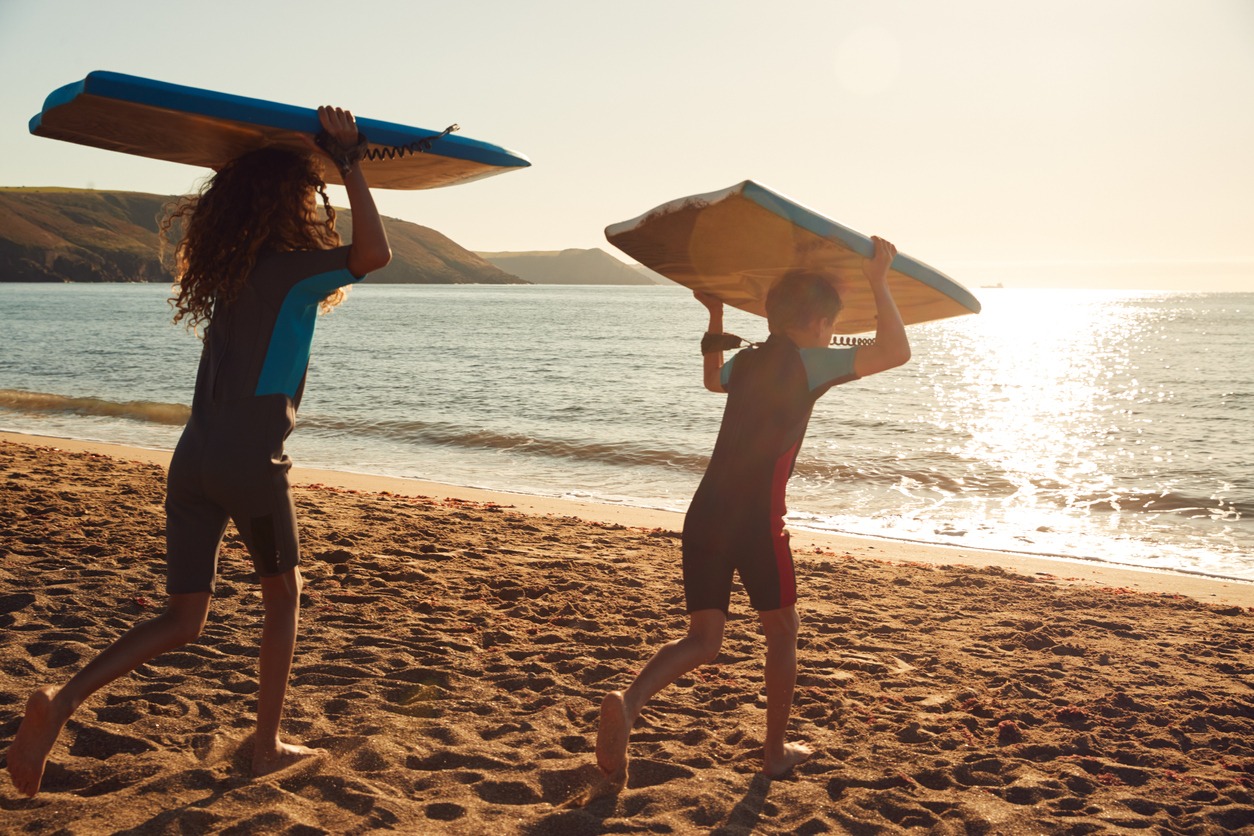Bodyboards or boogie boards are a wonderful addition to your kids’ arsenal of beach toys. It is lightweight and colorful and helps keep your child afloat in the water. This is a great option to leave the sand and learn to ride the waves! You can also use this in the river or waterparks.
Unlike skimboarding or surfing, where you have to identify the perfect wave, then hop on both legs and look for the center of your gravity to achieve a smooth ride, you only need to flop on your belly with a bodyboard. It is easy to teach and learn.
Children often lose interest in things, so starting your journey with a cheap beginner board made of Expanded Polystyrene (EPS) Styrofoam core is better. This usually has a leash attached to it so you can drag the board with your child on it, or he can tie it on his arms to easily tug on it when he falls over.
A child’s board is ideally one inch above his belly button. However, since children grow fast, you can also consider this factor.
Just as they outgrow clothes, they can also outgrow a board. If you get a longer board, you will have a challenge with balance and will be unable to maneuver it well. There will be more torso on top of the board and not enough legs to paddle in the water. This will affect your child’s ability to steer the board in the water. On the other hand, a board that is too small will have more weight at the bottom and will sink.
Consider the child’s weight as well when you are making a purchase. The weight determines the right board width and thickness, particularly if the child is on the heavy side. A heavy rider will need a board with a thicker and wider high-volume board because this will have more buoyancy. Look for boards labeled “high volume”.
Luckily, there are many great options for body boards in the market these days.
What to find in beach bodyguards for kids
1. Hammerhead Bodyboard style
Find a shark hammerhead-shaped bodyboard as a matter of getting a unique style. You can choose any color, as long as it has a leash for safety and a stability stringer.
It has to be made of high-quality lightweight Expanded Polyethylene (EPE) foam that can hold up to 300 pounds. It is advised that the board comes in with a structural replacement warranty.
2. Bodyboard made of High-Density Polyethylene
Choose a bodyboard that is made of High-Density Polyethylene (HDPE). For its core, you can also have Expanded Polystyrene (EPS) Styrofoam.
HDPE has higher tensile strength and shear strength, making it more resistant to wear and tear. This can turn your kid into a sturdy wave warrior as he or she uses the board in reef breaks without fear of breaking during wipeouts.
In terms of the total length, may sure that it is just right for kids up to preteens. It’s a plus if you can find one that is made of heat lamination technology to make sure that the color and design of the board do not flake off or fade easily.
3. Bodyboard with good buoyancy
Choosing a bodyboard brand that has an EPS core gives it good volume and buoyancy. With a slick bottom and a leash attached to it, you can be assured of a smooth ride on top of the waves.
4. Slider Board
You can also pick a plastic bodyboard that looks and feels like a toy. While this type of board may come in a lower price, what is important is you can grip the board on both sides.
5. A designer bodyboard
If you prefer a bodyboard that provides extra efficiency, you can pick a designer board. This type of board is considered a high-end, making it expensive. Interestingly, a designer board is popular and suitable for intermediate to advanced riders. This is definitely not your ordinary kid’s toy. This board is designed to pick up speed in a wave pocket in an effortless manner.
Some important answers to know kids’ body boarding
Your choice should be governed by your child’s interest and even accessibility to the ocean. It is common to buy cheap toys for kids because of their limited attention span; however, quality is important, too. If a board is not a floater and glider, it is not that fun.
Safety is also a top priority so a board with a leash is uncompromisable.
But even with a leash, keep your eyes on your kids when they are in the open ocean or, better yet, accompany them in the waters when they play.
The best place for kids to play is at a beach break. A beach break wave usually crashes on the shore of the beach. This beach has a shallow sand bottom, jetty or groyne, making it soft unlike reef breaks which has rocky or coral floors. Another plus for beach breaks is that there are multiple spots where your child can paddle out to the lineup.
Experts at Our Globe Trotters maintained kids around 4 to 5 years of age can already try boogie boards. Just make sure of the kid’s upper body strength and weight. They can start with smaller boards, like 33″ style of kids’ boogie board.
With the right supervision, bodyboards are an amazing beach toy for kids.
“Younger children can still enjoy trying to paddle or float in shallow water, whilst older children can learn how to ride small waves or simply enjoy the sensation of floating,” Our Globe Trotters emphasized.
Furthermore, it is recommended that for a unique experience, the bodyboard should also come with a padded top for additional comfort.
The padded top will ensure that your child can get down on his or her knees and ride the waves alone.
Conclusion
The best bodyboards for kids might not be cheap, but their performance and features make it all worthwhile. It won’t be a beach day without your kids joining in the fun, so do let them make the most of the waves with a reliable bodyboard.
However, no matter how safe and smooth these bodyboards run, there’s nothing to replace a watchful eye. Make sure any kid with a bodyboard is supervised at all times.

